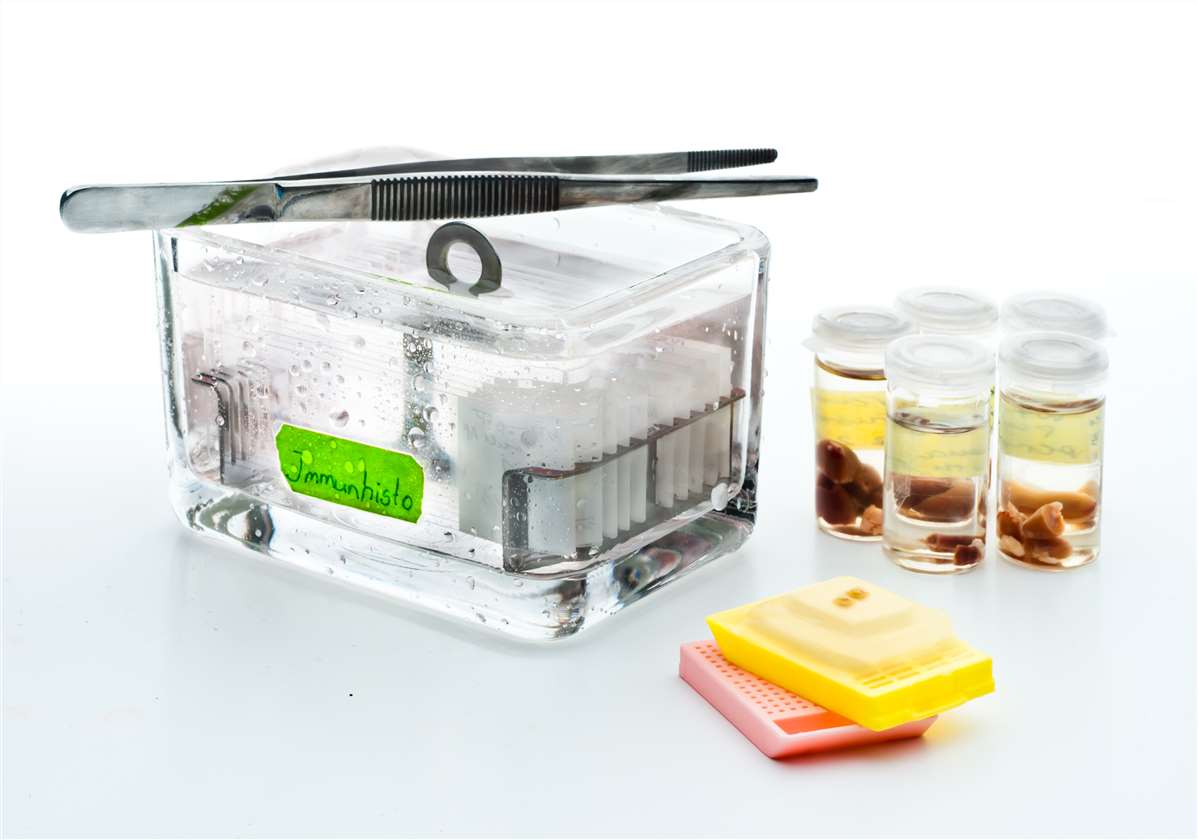Fixatives act by denaturing or precipitating proteins which then form a meshwork due to cross linking of proteins. This meshwork tends to hold the other cell constituent in vivo relation to each other and insoluble proteins provide mechanical strength for subsequent procedures.
Various types of fixatives (simple, compound, microanatomical, histochemical and cytological) are used in histology and histopathology which includes mercuric chloride, osmic acid, formaldehyde, glutaraldehyde, osmium tetroxide, glyoxal, picric acid, Zenker's fluid and so on.

Formalin is used for all routine surgical pathology and autopsy tissues when an H&E slide is to be produced. Formalin is the most forgiving of all fixatives when conditions are not ideal, causing no significant damage to tissue. It fixes most tissues well and is compatible with most ancillary testing such as immunohistochemistry and molecular testing.
Table 1. The advantages and disadvantages of formalin fixative.
| Advantages | Disadvantages |
| It is cheap, relatively stable and easy to prepare. | It may cause dermatitis and asthma in allergic individuals. |
| Tissue penetration is good. | It is slow to act (less tissue penetration). |
| Does not make tissues very hard or brittle. | There may be formation of dark brown artefact granules especially in tissues containing much blood (liver, spleen). |
| Allows most routine staining. | Reagent grade formalin (contains 10% methanol in addition to formaldehyde) is unsuitable for electron microscopy as methanol denatures proteins. However, pure formalin is suitable. |
| Frozen section is possible with formalin fixed tissues. | Gradual loss of basophilic staining or nucleus and cytoplasm. So, prolonged fixation is not advisable. |
| Natural color may be restored. | Loss of myelin reactivity when Weigert iron hematoxylin stain is used. |
| Most commonly used fixative and is the best fixative for the nervous system. |
Glutaraldehyde is recommended for tissue fixation for electron microscopy. The glutaraldehyde must be cold and buffered and not more than 3 months old. The tissue must be as fresh as possible, and preferably sectioned within the glutaraldehyde at a thickness no more than 1 mm to enhance fixation.
Table 2. The advantages and disadvantages of glutaraldehyde fixative.
| Advantages | Disadvantages |
| Formation of more cross linkages with better preservation of cellular & fluid proteins. | Expensive. |
| Resists acid hydrolysis. | Less stable. |
| Causes less shrinkage than formalin. | Penetrates tissue more slowly from formalin. |
| More pleasant & less irritant. | Inferior formalin for PAS satin. |
| Does not corrode metal. | |
| Does not cause dermatitis. |
Alcohols, especially ethanol, are used primarily for cytologic smears. Since the smear is only a cell or so thick, there is no great problem from shrinkage, and since the smear is not sectioned, there is no problem from induced brittleness.
Table 3. The advantages and disadvantages of alcohol fixative.
| Advantages | Disadvantages |
| Methyl alcohol (80-100%) is excellent fixative for smears. | Causes marked shrinkage, unless used at 0℃ or cooler. |
| Ethyl alcohol is used as a fixative for enzymes. | Distorts morphology and hardens the tissue. |
| Carnoy's fluid is used for urgent biopsy (paraffin processing within 5 hours). | Contraindicated for lipid study. |
| Good fixative to demonstrate glycogen. | Although glycogen can be demonstrated it causes polarization, as the streaming of glycogen granules to one pole of the cell. |
Zenker's fixative is recommended for reticuloendothelial tissues, including lymph nodes, spleen, thymus, and bone marrow. Zenker's fixes nuclei very well and gives good detail. However, the mercury deposits must be removed before staining or black deposits will result in the sections.
Table 4. The advantages and disadvantages of mercuric-containing fixative.
| Advantages | Disadvantages |
| Better staining of nuclei and connective tissue. Recommended for fixing fetal brain. | Solution rapidly deteriorates. |
| Gives best results for metachromatic staining. | Corrodes most metals except nickel alloy. |
| Cytoplasmic staining with acidic dyes is enhanced. | Zenker's solution removes iron of hemosiderin and causes RBC lysis. |
| Tissues become very hard and brittle if left for 1-2 days in fixation. | |
| Reduces the demonstrable glycogen in tissues. | |
| Not ideal for frozen sections. |
Bouin's solution is sometimes recommended for fixation of testis, GI tract, and endocrine tissue. It does not do a bad job on hematopoietic tissues either, and doesn't require dezenkerizing before staining.
Table 5. The advantages and disadvantages of Bouin's solution.
| Advantages | Disadvantages |
| It is a good fixative except mammalian kidney and penetrates rapidly. Shrinkage is minimal. | Prolonged fixation causes tissue hard and brittle. |
| Good fixative to demonstrate glycogen. | It lyses RBCs and reduces the iron content. |
| Small fragments easily visualized because of yellowish color after fixation. | Lipids are both altered & decreased. |
| Solution is stable. | |
| Best for testicular biopsies. |